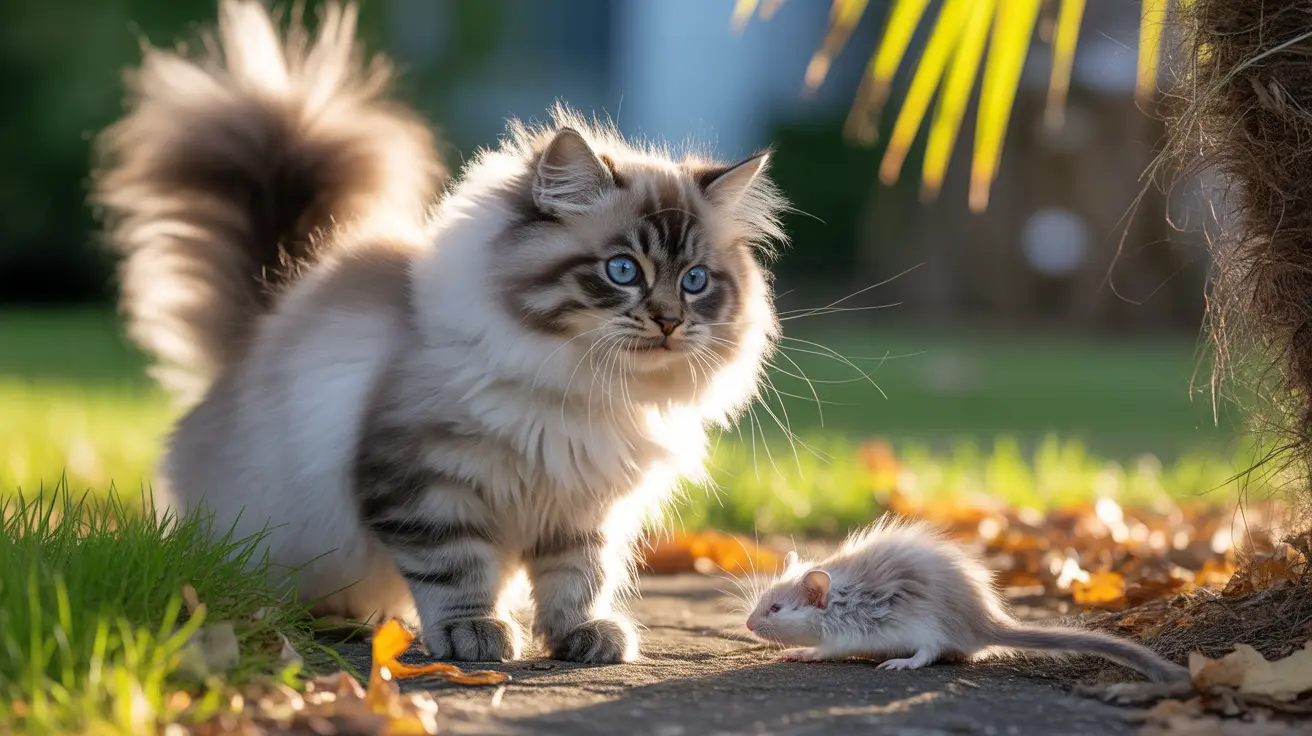House Cat Leads to Groundbreaking New Orthoreovirus Strain Discovery in Florida
In an extraordinary tale that highlights the unexpected ways scientific breakthroughs can occur, a house cat named Pepper has made headlines for contributing to the discovery of a previously unknown Orthoreovirus strain in Florida. This remarkable story began when Pepper, owned by Professor John Lednicky, brought a dead cotton mouse to her virologist owner, setting in motion a chain of events that would advance our understanding of these understudied but potentially significant viruses. The discovery underscores the critical role that domestic animals can play in zoonotic disease surveillance and pathogen identification.
This new Orthoreovirus strain discovery via cat represents more than just an interesting anecdote—it opens doors to enhanced viral research, improved recognition of orthoreovirus infections, and better treatment protocols for diseases caused by these complex pathogens. Orthoreoviruses are known to cause inflammatory diseases affecting the brain, spinal cord, and gastrointestinal tract, particularly in children, making this discovery potentially significant for public health. As we delve into this fascinating case study, we'll explore the biology of orthoreoviruses, their impact on human and animal health, and the broader implications of this feline-assisted scientific breakthrough.
Understanding Orthoreoviruses: The Science Behind the Discovery
Orthoreoviruses belong to the genus within the family Reoviridae and subfamily Spinareovirinae, representing a diverse group of viruses that infect vertebrates including mammals, birds, and reptiles. The genus Orthoreovirus encompasses ten distinct species: Avian orthoreovirus, Baboon orthoreovirus, Broome orthoreovirus, Mahlapitsi orthoreovirus, Mammalian orthoreovirus, Nelson Bay orthoreovirus, Neoavian orthoreovirus, Piscine orthoreovirus, Reptilian orthoreovirus, and Testudine orthoreovirus. This diversity reflects the wide range of hosts these viruses can infect and the varied pathogenic potential they possess.
Viral Structure and Characteristics
The structural complexity of orthoreoviruses is remarkable and directly relates to their ability to cause disease. These viruses possess a double-stranded RNA (dsRNA) genome consisting of 10 linear segments classified into large (L), medium (M), and small (S) size classes. Their virions are non-enveloped with icosahedral symmetry, measuring approximately 80–85 nm in diameter, and feature a distinctive double-layered protein capsid structure.
The inner capsid contains critical proteins including λ1, λ2, λ3, μ2, and σ2, while the outer capsid includes μ1 and σ3 proteins. Particularly important is the σ1 protein, which forms filamentous trimers responsible for cell attachment—a crucial step in viral infection. The λ3 protein functions as the RNA-dependent RNA polymerase, transcribing the dsRNA genome segments, while λ2 serves as a capping enzyme that adds essential modifications to viral mRNAs.
Transmission and Infection Mechanisms
Orthoreoviruses employ sophisticated mechanisms to enter host cells and establish infection. The process begins with the attachment of the σ1 protein to specific cellular receptors, including sialic acid and junctional adhesion molecule-A. This is followed by receptor-mediated endocytosis involving clathrin-coated pits. In the acidic environment of endosomes, partial uncoating occurs where the outer capsid protein σ3 is removed, exposing μ1, which then mediates membrane penetration and facilitates viral core release into the cytoplasm.
Transmission occurs primarily through the fecal-oral route and respiratory droplets, affecting various vertebrate hosts. This transmission pattern is particularly relevant to the Florida discovery, as the cotton mouse that Pepper brought home could have been infected through either route, demonstrating how wildlife can serve as reservoirs for these viruses.
The Significance of Pepper's Scientific Contributions
Professor John Lednicky's cat Pepper has established herself as an unlikely but valuable contributor to viral research. This isn't her first scientific contribution—Pepper previously helped identify the presence of Jeilongvirus in the United States in 2024, demonstrating a consistent pattern of inadvertent scientific assistance. The cat's natural hunting behavior provides researchers with access to potential disease vectors and wildlife specimens that might otherwise go unexamined.
What makes Pepper's contributions particularly valuable is that she remains healthy despite her exposure to various pathogens through her hunting activities. This observation provides insights into interspecies transmission patterns and highlights how domestic animals can serve as sentinels for emerging diseases without necessarily becoming ill themselves.
The Cotton Mouse Connection
The cotton mouse that led to this discovery represents a crucial link in understanding orthoreovirus ecology. Cotton mice are common rodents in the southeastern United States and can serve as reservoirs for various pathogens. The identification of a new orthoreovirus strain in this species suggests that wildlife populations may harbor previously unknown viral variants that could potentially impact human or domestic animal health.
Health Implications and Disease Manifestations
The discovery of new orthoreovirus strains has significant implications for understanding human and animal health impacts. Mammalian orthoreovirus infections in humans are typically asymptomatic or cause mild, self-limiting respiratory or gastrointestinal symptoms. However, the clinical picture can be more complex, particularly with certain strains and in vulnerable populations.
Pathophysiology and Disease Mechanisms
Orthoreoviruses induce pathological changes through multiple mechanisms, including apoptosis in infected cells through activation of death receptors such as TNFR, TRAIL, and Fas, along with regulation of cell cycle arrest. Some strains, particularly fusogenic orthoreoviruses, can cause more severe disease manifestations. For example, these strains can cause neurological illness in baboons and pneumonia in reptiles, demonstrating the variable pathogenic potential across different virus types and host species.
The newly identified strain's characteristics and pathogenic potential remain to be fully elucidated, but its discovery provides researchers with opportunities to study viral evolution, host adaptation, and potentially identify new therapeutic targets.
Pediatric Considerations
Orthoreoviruses show particular clinical relevance in pediatric populations, where they're known to cause inflammatory diseases affecting the brain, spinal cord, and gastrointestinal tract. This age-related susceptibility makes the discovery of new strains particularly important for pediatric infectious disease specialists and public health officials monitoring childhood illness patterns.
The Role of Domestic Animals in Disease Surveillance
The Florida discovery highlights the often-overlooked role of domestic animals in zoonotic disease surveillance and pathogen discovery. Cats, dogs, and other pets can serve as inadvertent collectors of environmental samples through their natural behaviors, providing researchers with access to wildlife specimens and potential disease vectors that might otherwise remain undetected.
Zoonotic Disease Monitoring
Domestic animals occupy a unique position at the interface between wild animal populations and human communities, making them valuable sentinels for emerging diseases. Their hunting behaviors, outdoor activities, and interactions with wildlife can provide early warning systems for new pathogens entering human-populated areas. This surveillance capability is particularly important given the increasing frequency of zoonotic disease emergence globally.
The success of Pepper's contributions demonstrates how pet owners, particularly those with scientific expertise, can leverage their animals' natural behaviors for research purposes while maintaining the pets' health and welfare.
Laboratory Analysis and Virus Identification Process
The process of identifying new viral strains from specimens brought by domestic animals involves sophisticated laboratory techniques and careful analysis. When Professor Lednicky received the cotton mouse from Pepper, the specimen underwent comprehensive viral screening using molecular diagnostic methods.
Diagnostic Techniques
Diagnosis of orthoreovirus infection relies on detection of viral RNA by RT-PCR in clinical samples such as tissue specimens from the infected mouse. Viral antigens can be detected through immunoassays, and virus isolation can be performed in various cell lines including mouse fibroblasts, monkey kidney cells, and HeLa cells. These techniques allow researchers to not only identify the presence of orthoreoviruses but also characterize new strains and compare them to known viral sequences.
The identification of the new strain likely involved genetic sequencing and phylogenetic analysis to determine its relationship to known orthoreovirus species and serotypes. Mammalian orthoreovirus includes three major serotypes (MRV-1, MRV-2, MRV-3) and a fourth minor serotype (MRV-4), and the new strain's classification within this framework provides insights into its potential biological properties and clinical significance.
Public Health Implications and Future Research Directions
The discovery of new orthoreovirus strains through this unconventional route has several important implications for public health policy and research priorities. First, it demonstrates the need for enhanced surveillance of wildlife populations and the pathogens they carry. Second, it highlights the value of engaging pet owners and veterinarians in disease surveillance efforts.
Research Opportunities
This discovery opens new avenues for research into orthoreovirus biology, evolution, and pathogenesis. Understanding how new strains emerge and adapt to different host species can inform predictions about future disease threats and guide development of diagnostic tools and therapeutic interventions. The newly identified strain could also contribute to ongoing research into the oncolytic properties of orthoreoviruses, as mammalian orthoreovirus serotype 3 has shown promise in clinical trials as a cancer therapy due to its ability to selectively kill tumor cells.
Environmental and Ecological Considerations
The presence of previously unknown orthoreovirus strains in wildlife populations raises questions about environmental factors that might influence viral evolution and emergence. Climate change, habitat destruction, and increased human-wildlife interfaces may all contribute to the appearance of new viral variants, making continued surveillance and research essential for public health preparedness.
Safety Guidelines for Pet Owners
While Pepper's contributions to science are remarkable, pet owners should be aware of proper safety protocols when their animals bring home wildlife specimens or show signs of illness after wildlife encounters.
Safe Handling Practices
Pet owners should avoid direct contact with any wildlife specimens their animals bring home and should use gloves and other protective equipment when disposing of such materials. If pets show signs of illness after wildlife encounters, veterinary consultation is recommended. Additionally, maintaining regular veterinary care and vaccinations for pets can help protect both animals and their human families from zoonotic diseases.
For pet owners interested in contributing to scientific research, establishing relationships with local universities, veterinary schools, or public health departments can provide appropriate channels for reporting unusual findings while ensuring proper safety protocols are followed.
Frequently Asked Questions
- Q: What exactly is an orthoreovirus and why should people be concerned about new strains?
Orthoreoviruses are a genus of double-stranded RNA viruses that infect vertebrates including mammals, birds, and reptiles. While mammalian orthoreovirus infections in humans are typically mild or asymptomatic, causing self-limiting respiratory or gastrointestinal symptoms, some strains can cause inflammatory diseases affecting the brain, spinal cord, and gastrointestinal tract, particularly in children. New strains are important because they may have different pathogenic properties or transmission patterns that could impact public health.
- Q: How did a house cat contribute to discovering a new virus strain?
Professor John Lednicky's cat Pepper brought a dead cotton mouse to her owner, who is a virologist. Professor Lednicky analyzed the specimen and discovered it contained a previously unknown orthoreovirus strain. This demonstrates how domestic animals can inadvertently serve as collectors of scientific specimens through their natural hunting behaviors.
- Q: Is it dangerous for pets to hunt wildlife that might carry viruses?
While pets can be exposed to various pathogens through wildlife contact, most healthy domestic animals have robust immune systems that protect them from many diseases. However, pet owners should maintain regular veterinary care, keep vaccinations current, and practice safe handling of any wildlife specimens their pets bring home. In Pepper's case, the cat shows no signs of illness despite her contributions to viral research.
- Q: How do scientists identify new virus strains from animal specimens?
Scientists use molecular diagnostic techniques such as RT-PCR to detect viral RNA in tissue samples, followed by genetic sequencing and phylogenetic analysis to compare new findings to known viral sequences. Virus isolation in cell culture and immunoassays for viral antigens are also employed. This comprehensive approach allows researchers to characterize new strains and determine their relationship to existing viral classifications.
- Q: What are the potential benefits of discovering new orthoreovirus strains?
Discovering new orthoreovirus strains advances viral research by improving our understanding of viral evolution, host adaptation, and pathogenesis. This knowledge can lead to better diagnostic tools, treatment protocols, and prevention strategies. Additionally, some orthoreoviruses have shown promise as cancer therapies due to their ability to selectively kill tumor cells, so new strains might offer additional therapeutic opportunities.
- Q: Should pet owners be worried about their animals bringing home dead wildlife?
While pet owners should exercise caution when handling wildlife specimens, this behavior is natural for many cats and dogs. The key is proper safety protocols: avoid direct contact with specimens, use protective equipment when disposing of them, monitor pets for signs of illness, and maintain regular veterinary care. Most pets remain healthy despite wildlife encounters, as demonstrated by Pepper's continued good health.
- Q: How might this discovery impact public health policy?
This discovery highlights the importance of wildlife surveillance and the potential role of domestic animals in disease monitoring. It may lead to enhanced collaboration between veterinarians, pet owners, and public health officials in surveillance efforts. The finding also emphasizes the need for continued research into emerging pathogens and their potential impacts on human and animal health.
Conclusion
The remarkable story of how a house cat's natural hunting instincts led to the discovery of a new Orthoreovirus strain in Florida exemplifies the unexpected pathways through which scientific knowledge advances. Pepper's contribution to viral research not only resulted in the identification of a previously unknown pathogen but also demonstrated the valuable role that domestic animals can play in disease surveillance and scientific discovery.
This new Orthoreovirus strain discovery via cat opens important avenues for future research into viral evolution, pathogenesis, and the complex relationships between wildlife, domestic animals, and human health. As we continue to face emerging infectious disease threats globally, stories like Pepper's remind us that scientific breakthroughs can come from the most unexpected sources and that maintaining curiosity about the natural world around us—even in our own backyards—can lead to significant advances in our understanding of microbial diversity and disease ecology.






